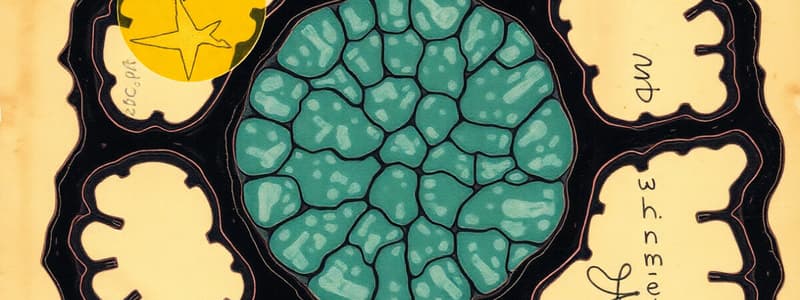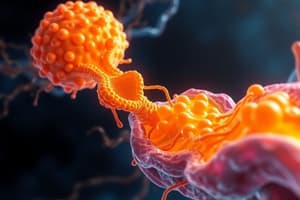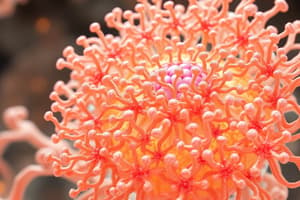Podcast
Questions and Answers
What is a primary function of the Smooth Endoplasmic Reticulum?
What is a primary function of the Smooth Endoplasmic Reticulum?
- DNA replication
- Cell division
- Lipid synthesis (correct)
- Protein synthesis
Which type of protein remains embedded in the ER membrane?
Which type of protein remains embedded in the ER membrane?
- Transmembrane proteins (correct)
- Secretory proteins
- Cytoplasmic proteins
- Water-soluble proteins
Which process is NOT associated with the Smooth Endoplasmic Reticulum?
Which process is NOT associated with the Smooth Endoplasmic Reticulum?
- Protein folding (correct)
- Steroid hormone secretion
- Detoxification of drugs
- Metabolism of carbohydrates
What happens to proteins after post-translational processing?
What happens to proteins after post-translational processing?
Which type of cells is the Smooth ER particularly well developed in, related to steroid secretion?
Which type of cells is the Smooth ER particularly well developed in, related to steroid secretion?
What is one of the mechanisms by which the Smooth ER helps maintain blood glucose levels?
What is one of the mechanisms by which the Smooth ER helps maintain blood glucose levels?
What can cause an increase in the proliferation of the smooth endoplasmic reticulum in liver cells?
What can cause an increase in the proliferation of the smooth endoplasmic reticulum in liver cells?
Which enzyme is involved in the conversion of glucose-6-phosphate to glucose in the Smooth ER?
Which enzyme is involved in the conversion of glucose-6-phosphate to glucose in the Smooth ER?
What is the primary function of lysosomes?
What is the primary function of lysosomes?
At what pH do lysosomal enzymes exhibit optimum activity?
At what pH do lysosomal enzymes exhibit optimum activity?
Which of the following best describes the composition of lysosomes?
Which of the following best describes the composition of lysosomes?
What is the role of the Golgi apparatus in lysosome formation?
What is the role of the Golgi apparatus in lysosome formation?
Which type of granules is associated with the transport of secretory products?
Which type of granules is associated with the transport of secretory products?
What type of organelles are peroxisomes often referred to as?
What type of organelles are peroxisomes often referred to as?
Which of the following substances are synthesized in the Golgi apparatus?
Which of the following substances are synthesized in the Golgi apparatus?
What characterizes secondary lysosomes?
What characterizes secondary lysosomes?
What is the primary role of the sarcoplasmic reticulum in muscle cells?
What is the primary role of the sarcoplasmic reticulum in muscle cells?
Which of the following statements about the Golgi apparatus is correct?
Which of the following statements about the Golgi apparatus is correct?
What distinguishes the sarcoplasmic reticulum from the smooth endoplasmic reticulum?
What distinguishes the sarcoplasmic reticulum from the smooth endoplasmic reticulum?
Which of the following functions is NOT performed by the smooth endoplasmic reticulum?
Which of the following functions is NOT performed by the smooth endoplasmic reticulum?
What happens to proteins entering the Golgi apparatus at the cis face?
What happens to proteins entering the Golgi apparatus at the cis face?
How many cisternae typically make up the Golgi apparatus?
How many cisternae typically make up the Golgi apparatus?
Which statement about the trans face of the Golgi apparatus is true?
Which statement about the trans face of the Golgi apparatus is true?
What is NOT a characteristic function of the smooth endoplasmic reticulum?
What is NOT a characteristic function of the smooth endoplasmic reticulum?
In which type of cells is the sarcoplasmic reticulum primarily found?
In which type of cells is the sarcoplasmic reticulum primarily found?
Which of the following best describes the function of the Golgi apparatus?
Which of the following best describes the function of the Golgi apparatus?
What characteristic distinguishes rough endoplasmic reticulum from smooth endoplasmic reticulum?
What characteristic distinguishes rough endoplasmic reticulum from smooth endoplasmic reticulum?
What is one of the roles of the Golgi apparatus?
What is one of the roles of the Golgi apparatus?
Which of the following describes the structure of the endoplasmic reticulum?
Which of the following describes the structure of the endoplasmic reticulum?
What is the role of ribosomes attached to the rough endoplasmic reticulum?
What is the role of ribosomes attached to the rough endoplasmic reticulum?
How can the endoplasmic reticulum localize in certain cytoplasmic areas?
How can the endoplasmic reticulum localize in certain cytoplasmic areas?
What type of cells would contain more rough endoplasmic reticulum?
What type of cells would contain more rough endoplasmic reticulum?
In what context is the nuclear envelope partially reformed?
In what context is the nuclear envelope partially reformed?
What is the primary function of catalase in peroxisomes?
What is the primary function of catalase in peroxisomes?
Which process is involved in the release of insulin from secretory granules?
Which process is involved in the release of insulin from secretory granules?
What are the potential consequences of Zellweger syndrome?
What are the potential consequences of Zellweger syndrome?
What type of enzymes do peroxisomes contain for oxidation reactions?
What type of enzymes do peroxisomes contain for oxidation reactions?
What is a by-product of the oxidation reactions occurring in peroxisomes?
What is a by-product of the oxidation reactions occurring in peroxisomes?
What is the primary role of secretory granules in certain cells?
What is the primary role of secretory granules in certain cells?
Where do secretory vesicles originate from?
Where do secretory vesicles originate from?
Which statement is true regarding the ratio of mitochondria and the presence of peroxisomes?
Which statement is true regarding the ratio of mitochondria and the presence of peroxisomes?
Flashcards
Endoplasmic Reticulum (ER)
Endoplasmic Reticulum (ER)
An extensive network of membranes that forms interconnected channels and flattened sacs called cisternae within a cell, responsible for various cellular functions.
Rough Endoplasmic Reticulum (RER)
Rough Endoplasmic Reticulum (RER)
The type of ER that has ribosomes attached to its surface, giving it a granular appearance. It plays a crucial role in protein synthesis and transport.
Protein Synthesis
Protein Synthesis
The process by which ribosomes synthesize proteins based on genetic instructions from DNA.
Smooth Endoplasmic Reticulum (SER)
Smooth Endoplasmic Reticulum (SER)
Signup and view all the flashcards
Detoxification
Detoxification
Signup and view all the flashcards
Sarcoplasmic Reticulum
Sarcoplasmic Reticulum
Signup and view all the flashcards
Golgi Apparatus
Golgi Apparatus
Signup and view all the flashcards
Lysosomes
Lysosomes
Signup and view all the flashcards
SER Detoxification
SER Detoxification
Signup and view all the flashcards
SER Steroid Synthesis
SER Steroid Synthesis
Signup and view all the flashcards
SER Calcium Storage
SER Calcium Storage
Signup and view all the flashcards
SER Lipid Synthesis
SER Lipid Synthesis
Signup and view all the flashcards
SER Carbohydrate Metabolism
SER Carbohydrate Metabolism
Signup and view all the flashcards
SER Blood Glucose Regulation
SER Blood Glucose Regulation
Signup and view all the flashcards
SER Proliferation
SER Proliferation
Signup and view all the flashcards
Excitation-Contraction Coupling (ECC)
Excitation-Contraction Coupling (ECC)
Signup and view all the flashcards
Cis Golgi Network (CGN)
Cis Golgi Network (CGN)
Signup and view all the flashcards
Trans Golgi Network (TGN)
Trans Golgi Network (TGN)
Signup and view all the flashcards
Vesicles
Vesicles
Signup and view all the flashcards
Cisternae
Cisternae
Signup and view all the flashcards
Lumen
Lumen
Signup and view all the flashcards
What is the role of the Golgi apparatus?
What is the role of the Golgi apparatus?
Signup and view all the flashcards
What function does the Golgi apparatus have in carbohydrate synthesis?
What function does the Golgi apparatus have in carbohydrate synthesis?
Signup and view all the flashcards
What are lysosomes and what is their role in the cell?
What are lysosomes and what is their role in the cell?
Signup and view all the flashcards
Where do lysosomes originate from?
Where do lysosomes originate from?
Signup and view all the flashcards
How are lysosomal enzymes synthesized and modified?
How are lysosomal enzymes synthesized and modified?
Signup and view all the flashcards
Why are lysosomes important in the cell?
Why are lysosomes important in the cell?
Signup and view all the flashcards
What are peroxisomes and what is their main function?
What are peroxisomes and what is their main function?
Signup and view all the flashcards
What specific functions are peroxisomes involved in?
What specific functions are peroxisomes involved in?
Signup and view all the flashcards
Peroxisomes
Peroxisomes
Signup and view all the flashcards
Hydrogen Peroxide (H2O2)
Hydrogen Peroxide (H2O2)
Signup and view all the flashcards
Catalase
Catalase
Signup and view all the flashcards
Zellweger Syndrome
Zellweger Syndrome
Signup and view all the flashcards
Secretory Granules
Secretory Granules
Signup and view all the flashcards
Exocytosis
Exocytosis
Signup and view all the flashcards
Insulin
Insulin
Signup and view all the flashcards
Study Notes
Cell Structure: Endoplasmic Reticulum (Smooth and Rough), Golgi
- The Endoplasmic Reticulum (ER) is a vast network of interconnected membranes in animal cells.
- It can occupy up to 50% of the total membrane surface.
- The ER extends from the nuclear envelope nearly to the plasma membrane, and is a transport network.
- The channels and tubules in the ER sometimes expand to form flattened sacs called cisternae.
- This structure can localise the ER to specific cytoplasmic areas.
Two Types of ER
-
Rough ER (RER):
- Characterized by ribosomes attached to its surface, giving it a granular appearance.
- Primarily involved in protein synthesis.
- The ribosomes on the rough ER synthesize proteins that will be incorporated into the membrane or secreted from the cell.
- Processes like protein folding and modification also occur in the rough ER lumen.
-
Smooth ER (SER):
- Lacks ribosomes, appearing smooth.
- Involved in lipid synthesis and metabolism of carbohydrates.
- Also plays a role in detoxification of harmful substances.
- Involved in steroid hormone synthesis, found in high concentrations in endocrine cells and glands.
- Stores and regulates calcium ions (Ca²⁺) in specific cells, like the sarcoplasmic reticulum in skeletal muscle cells.
Sarcoplasmic Reticulum
- Specialised form of smooth ER in smooth and skeletal muscle cells.
- Responsible for storing and releasing calcium ions (Ca²⁺).
- Crucial for excitation-contraction coupling (ECC) in muscle cells.
Golgi Apparatus
- This organelle is present in all eukaryotic cells.
- It is involved in processing, sorting, and packaging proteins and lipids for transport to their specific destinations.
- Found in all eukaryotic cells.
- May also modify membrane carbohydrates.
- Golgi apparatus is found in some animal cells near the nucleus, in an area called the centrosome.
- In plant cells, there are numerous, dispersed Golgi bodies throughout the cytoplasm.
Golgi Apparatus - Structure
- Composed of flattened, membrane-bound sacs called cisternae, which vary from 3 to 7.
- These cisternae are interconnected by tubules.
- Different faces of the Golgi have different functions:
- The cis face receives proteins and lipids from the ER and modifies them.
- The trans face packages and sends them to their destinations (e.g., lysosomes, plasma membrane, secretion).
Golgi Apparatus - Function
- The main function is to process, sort, and package proteins and lipids.
- Modifies proteins after synthesis.
- Plays a role in the transport of molecules to other parts of the cell.
- Participates in the formation of lysosomes, which are involved in breaking down waste materials.
- Involved in the synthesis of polysaccharides and glycosaminoglycans (GAGs).
Membrane-bound Vesicles and Secretory Granules
-
Lysosomes:
- Contain hydrolytic enzymes for intracellular digestion.
- Formed by the Golgi apparatus.
- Fuse with other vesicles containing material to be degraded, forming secondary lysosomes for the actual digestion.
-
Peroxisomes:
- Contain oxidative enzymes, involved in various metabolic processes, particularly involving breaking down harmful substances, including the removal of hydrogen peroxide.
- Some have a crystalline core in their matrix.
-
Secretory Granules/Vesicles:
- Used by cells that rapidly secrete products (usually proteins).
- Store products within these granules and release them via exocytosis when stimulated.
- Often found in cells that produce and release hormones, neurotransmitters.
Studying That Suits You
Use AI to generate personalized quizzes and flashcards to suit your learning preferences.




